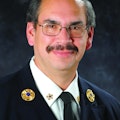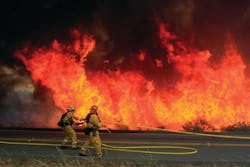Editor’s Note: The Firehouse staff wanted to share some of long-time Editor in Chief Harvey Eisner’s work. Harvey, a fixture on New York City firegrounds and at major events and conferences since the 1970s, passed away on Oct. 23. He was 59. He has worked with Firehouse since its inception in 1976. He began serving with the Tenafly, N.J., Fire Department in 1975 and served as chief for 12 years.
Recently, my mutual aid association held a drill about rail incidents on a busy rail line where numerous 100-plus-car trains travel each day. Bakken crude oil and liquefied propane gas (LPG) are among the hazardous materials being transported routinely. Federal regulations issued require rail carriers to notify states where trains carrying 1 million gallons of crude oil are passing through. After the drill, I was told that the exercise raised many new questions regarding evacuation communications, strategy and tactics, water supply, exposures and Office of Emergency Management procedures. Will responders be fighting a fire while addressing concerns about water/oil runoff and exhausting their existing water supplies? Dealing with the abundant and increasing amount of oil being transported across the country provides some interesting discussion for decision makers.
The fire service, from the first unit on the scene of any type of incident, makes a decision on whether to operate in an aggressive, offensive manner or take a defensive position. Many factors go into making this decision. Some prove to be right and some turn out wrong. The effect of that decision can sometimes prove fatal. Can the building be saved? Is there a life hazard? In essence, what are we trying to do? Recently, I drove past the former location of the Hackensack, NJ, car dealership where five firefighters were killed in the collapse of a wooden bow-string truss roof on July1, 1988. Today, 26 years later, cars are parked there. The members killed are remembered on a monument a few blocks away.
As I travel around the country, I see so many departments are saving lives by responding to EMS calls. One person said I grew up in the time of fire, he grew up in the time of hazmat and now it’s the time of EMS. That is the way the cycle seems to be going. Today, firefighters respond to all types of emergencies and save more lives than ever. EMS is saving lives as well as jobs and entire departments. Think about it: If we didn’t respond to all the EMS incidents and unusual emergencies to which we are called, why would the public need us? We still perform a live-saving function, just under a new set of circumstances.
Live-fire tests conducted through Underwriters Laboratories (UL), the National Institute of Standards and Technology (NIST) and a host of others are gaining interest all across the country. The fire service is finally listening to the new outcomes and is putting these options in our arsenal or tool box and will use them when the conditions warrant. We are in some exciting times – just watch some of these tests and their results.
The fire chief has to make decisions about how to position the troops, decide on a strategy to mitigate the incident and protect not only the firefighters, but civilians in danger. Company officers must operate effectively and keep their units as safe as possible. It is a dangerous job, but some of the risks can be reduced or at least monitored. Firefighters decide whether to enter an area of danger. They have a choice on whether to use their personal protective equipment (PPE) as a defensive weapon, not offensive. Too many firefighters are killed in areas where they probably didn’t belong.
Whether you wear a white uniform shirt or a blue T-shirt, regardless of what patch is on your sleeve, the color of your apparatus or which state your are from, what matters is that you get all the education and training you can. The fire service continually updates itself by keeping up with new threats, problems and potential life-threatening situations. Wherever there is a major traffic accident, a school shooting or other emergency, fire apparatus and fire department ambulances are on the scene, working hand in hand with law enforcement and other agencies in a leading or support role. Times are changing.
This month, we present our annual Firehouse Expo conferences and exhibits in Baltimore, MD. We hope you’ll join us July 15-19 for the latest in education and fire service products, services and technologies.
FOR COMMENTS AND SUGGESTIONS, please contact us at [email protected].
43
2014 firefighter line-of-duty deaths at press time.
1,278
2014 residential fire fatalities at press time.
About the Author

Harvey Eisner
Editor Emeritus
HARVEY EISNER was named Editor Emeritus of Firehouse® after serving 15 years as Firehouse's Editor-in-Chief. He joined the Tenafly, NJ, Fire Department in 1975 and served as chief of department for 12 years. He was a firefighter in the Stillwater, OK, Fire Department for three years while attending Oklahoma State University. Eisner was an honorary assistant chief of the FDNY and program director for the Firehouse Expo, Firehouse World and Firehouse Central conferences. He covered many major fires and disasters and interviewed numerous fire service leaders for Firehouse®
